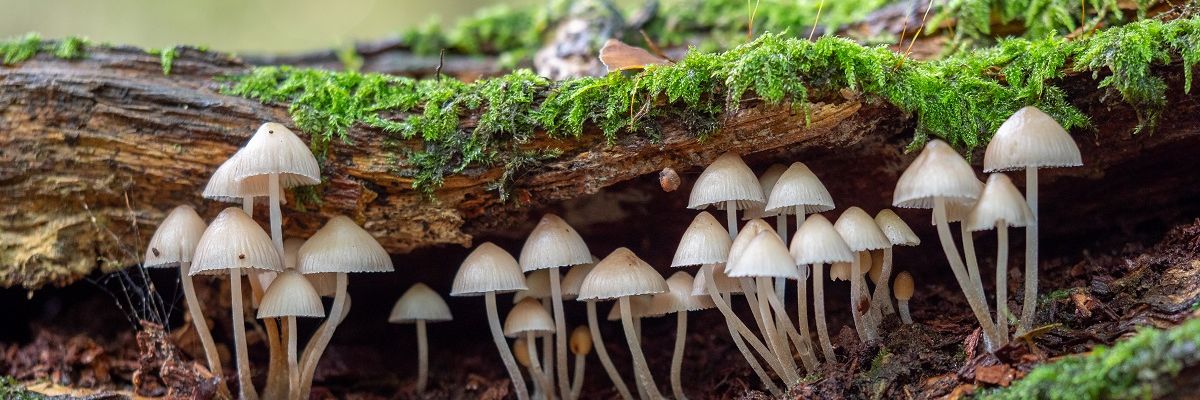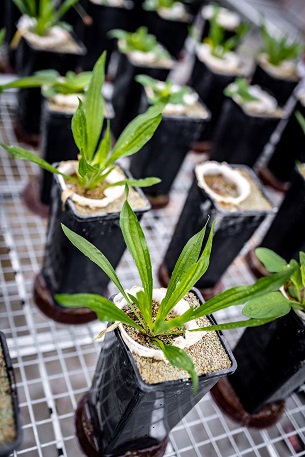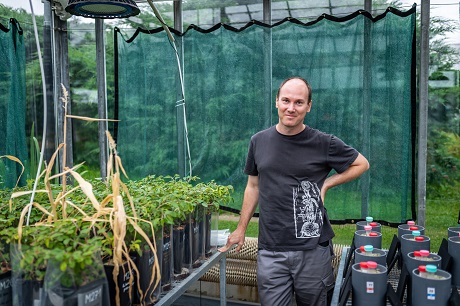
A lifelong partnership: the secret inner world of fungi and plants
09. 05. 2022
Millions of years ago, fungi made it possible for plants to make the transition from water to land, and they continue to help them to this day by being a source of hard-to-find nutrients and helping their hosts overcome stress. What does the partnership between fungi and plants look like? How do they communicate and exchange important nutrients? Read below to find out.
When in 1885, the German naturalist Albert Bernhard Frank was investigating possible ways of growing truffles in the Kingdom of Prussia, he stumbled upon a remarkable thing. He discovered that the roots of many species of trees were intertwined with fungi, both on the inside and outside, and did not seem to be harming each other, benefiting from the relationship instead. He dubbed this phenomenon mycorrhiza (from the Greek mykes, fungus, and rhiza, root). The German scholar correctly guessed at the time that the fibres of the mycelium complement the root system of plants and a regular exchange of minerals and nutrients occurs between the two partners. He was astonished that such an abundant and interesting phenomenon had not yet received due attention.
The formations observed more than 130 years ago by Albert Bernhard Frank on tree roots were visible to the eye. They were made up of large fungi – truffles are classified as Ascomycota, or sac fungi, but symbiosis is also favoured by Basidiomycetes, which constitute most known forest fungi, including bolete mushrooms.
This type of symbiosis, though the best known, is not the most common. By far the most widespread type is arbuscular mycorrhiza. It is not visible to the eye because microscopic fungi are involved, but it affects the vast majority of our herbaceous plants, including agricultural crops and some woody plants.
A partnership to last hundreds of millions of years
When land plants emerged in the Ordovician and Silurian periods more than 420 million years ago, they did not have a well-developed root system. It appears it was fungi that helped these plants significantly with their change of lifestyle, colonising the new terrestrial environment. To put it simply, and this still holds true today, the filamentous structure of mycelium expanded the root system of plants. Picture mycelium as a subterranean, intricate network of very thin, thread-like hyphae, measuring on average three to four picometres. The hyphae not only surround the roots of the plant, but even grow inwards, comprising a very close, almost intimate, coexistence.
“It’s a mutually beneficial relationship, with the fungus supplying nutrients to the plant and the plant in turn supplying carbon to the fungus. The fungus can absorb nutrients even from very small soil pores and the mycelium grows faster than the plant roots,” explains Martina Janoušková, head of the Department of Mycorrhizal Symbioses at the Institute of Botany of the CAS.
So how should we imagine this fungi-arbuscular mycorrhiza synergy? It is primarily an extensive and rich network of mycelia underground. Their spores can remain in the soil for years and can survive independently of the plant, withstanding periods of prolonged drought and then activating as soon as the conditions are right and a partner plant appears. The spores then grow into hyphae, which have the task of seeking out the plant’s roots.
If they fail to do so, they eventually die. If they succeed, they branch out across the surface of the root. The fan-like formations begin to grow through the cells of the top layer into the cells of the primary root cortex. Subsequently, the fungus penetrates and grows underneath the cortical cell wall, where it forms highly branched structures called arbuscules (which give the name to this type of mycorrhiza). Arbuscules are tightly enveloped by the cytoplasmic membrane of the host, and it is at these points of closest contact between the two partners that the most intense exchange of nutrients occurs. Once the plant begins to feed the fungus with carbon, an extensive network of mycelial hyphae begins growing out of the roots into the soil matrix.
Life below ground
Such close co-operations occur exclusively below ground. Arbuscular mycorrhiza is most active in young roots when the plant is developing and in acute need of sufficient mineral and nutrient intake: particularly phosphorus, but also nitrogen, zinc, and copper, which the plant cannot obtain in sufficient quantities from the soil. Why can’t it do this on its own?
Let’s demonstrate on the example of phosphorus. The main source of phosphate uptake for plants and fungi is the dihydrogen phosphate (H2PO4-), which binds strongly to the surfaces of soil particles, is basically immobile in the soil, and thus results in rapid depletion of it in the vicinity of the roots. Unlike the cumbersome roots, the thin hyphae can grow rapidly to reach new supplies of phosphorus, even in the smallest of soil pores. Much of the phosphorus acquired is released by the fungus as dihydrogen phosphate into the narrow space between the arbuscule and the plasma membrane of the plant cell. For phosphate uptake, plants have specialised carriers in the plasma membrane that only appear in the vicinity of fungal structures. They are completely absent when plants are grown in sterile soil without the presence of fungi.

Arbuscular mycorrhizae research in the greenhouses of the Institute of Botany of the CAS in Průhonice. One of the model plants is ribwort plantain. (CC)
Many species of plants forming arbuscular mycorrhiza make do quite well without fungi if they have enough nutrients at their disposal. On the other hand, the highly specialised fungi that control this type of mycorrhiza wholly depend on plants for their carbon nutrition; they are obligate symbionts. The intricate relationship between fungi and plants is thus arguably a very uneven partnership.
The two participants communicate with each other, giving each other signals during the symbiosis, from which the plant can recognise, for example, that the fungus penetrating the roots is not an enemy but a friend. Additional communication then takes the form of nutrient exchange: the flow of nutrients from the fungus to the plant and carbon from the plant to the fungus. For example, in nutrient-rich soil (typically the artificial fertilisers used in intensive agriculture), the plant needs much fewer nutrients from the fungus than in nutrient-deficient soil and communicates this by providing a reduced carbon supply. Thus, in such an environment, the fungus is dormant and mycorrhiza may not appear at all.
In nature, the root system of every plant is colonised by various species of arbuscular mycorrhizal fungi which differ in their characteristics, such as their ability to supply the host plant with specific nutrients and to extract carbon from it. It is known from experiments that when a plant interacts with two species of fungi, it can tell which one provides it with more nutrients. It “pampers” the more reliable partner and provides it with more carbon than the fungus that isn’t as helpful. And apparently, it works the other way around, too. Even fungi colonise several species of plants at once (imagine a meadow where the plants are connected below ground by a mix of different fungal mycelia). Fungi seem to direct the flow of nutrients from the soil to those plants from which they receive more carbon. “There is a number of experiments demonstrating such cooperation, but the exact process at the molecular level has not yet been described,” adds Martina Janoušková.
Fungi against drought
As well as providing their hosts with nutrients, fungi also help them overcome stress, which is imperative for plants which, unlike animals, cannot escape adverse conditions. Fungi can play an important role in times of drought, for example. Thus, research of the impact of arbuscular mycorrhizae in agriculture is the focus of research teams around the world, including that of Martina Janoušková and her colleagues.
“In an earlier experiment, we looked at how the presence of mycorrhizal fungi affects the phosphorus uptake capability of plants over a wide soil moisture gradient. Under drought conditions, the role of the fungi was crucial; without them, our tested plants were virtually unable to obtain phosphorus,” explains David Püschel from the Department of Mycorrhizal Symbioses. On the other hand, when the soil contained sufficient amounts of water, the importance of mycorrhizae was not so noticeable.
Currently, the researcher is working on a similar research project, this time focusing on nitrogen uptake. “Again, we create soil conditions with varying degrees of available water: from an excess to a significant deficit. We then observe to what extent the plants are able to absorb nitrogen from the organic or inorganic source we are providing them with at that moment, and what role mycorrhizal fungi play in this,” he describes the experiment in the greenhouse of the Institute of Botany of the CAS in Průhonice. “In addition, this nitrogen source is labelled with the 15N isotope, which allows us, when analysing the biomass, to quantify the nitrogen uptake during the period of the plants’ life when they were exposed to drought.”

David Püschel from the Institute of Botany of the CAS. (CC)
It turns out that fungi not only help plants with nutrient uptake, but also to a certain extent influence water availability. Previously, researchers had thought that water could reach plants from within the fungal mycelium in a similar way to water flowing through water pipes. However, current research suggests that this does not seem to be the case and that mycorrhiza has a more indirect effect. In fact, the presence of fungal structures in soil pores affects the hydraulic conductivity of this environment. “This makes it easier for water to spread on its own through capillary forces and to get close to the root hairs of the plants, which then absorb it,” David Püschel adds. If the drought gets so severe that the plants cannot grow, let alone feed their mycorrhizal partner, the fungus rests, biding its time for more favourable conditions. When these conditions arise and vegetation recovers, the fungus is given a signal and it comes back to life.
Inoculation with fungi
A few years ago, a tweet by Bill Gates sparked a reaction among researchers studying mycorrhizae. Under an image of a root coated with the spores of an arbuscular mycorrhizal fungus, Gates wrote that it “could help feed the hungry”. He was referring to one of the studies that researched using the fungus to increase the yield of cassava, an important tropical crop (its starch, tapioca, is considered a staple food in tropical countries). In it, researchers worked with the possibility of cultivating effective isolates of symbiotic fungi. As it later turned out, it’s not so easy. However, the potential is there and research into the role of mycorrhizal fungi in agriculture continues. In fact, most agricultural crops – including wheat, rice, and maize – form arbuscular mycorrhizae, during which the “friendly” fungi evidently improve the crop’s growth (unlike, for example, rapeseed, which does not maintain a symbiotic relationship with fungi).
Fungi can be artificially added to plants by a process of inoculation. In this case, the inoculum comprises fungal spores and hyphae prepared in advance via targeted cultivation. The substrate containing the fungus is added to the soil – however, there’s a catch, as it only takes hold where conditions are suitable for it. If soils are over-fertilised, with an excess of nutrients, the added fungi do not form functional mycorrhizae.
So far, therefore, inoculation experiments have been more successful in soils where fungi have the potential to thrive but for some reason are absent: for example, in areas affected by severe erosion, but in some arable soils as well. Tropics, subtropics, and soils with low phosphorus availability are suitable for experiments. However, it can also work in European conditions. On the other hand, it is useless to inoculate a substrate in which the fungi have no chance of success. “In nutrient-rich soils, fungi are scarce simply because the plants do not need them. So there is no point in adding them artificially,” Martina Janoušková remarks.
And back on the subject of relationships: plants and fungi, which have co-existed for millions of years in a kind of entangled partnership, largely manage their relationships themselves. Their way of communicating with each other is not yet entirely clear to us, but what is certain is that they do. Their mutual communication seems to be driven by biochemical processes, similarly as relationships between humans are. In the 19th century, the naturalist Albert Bernhard Frank wondered how it was possible that mycorrhiza did not receive the attention it deserved. Nearly two hundred years later, the phenomenon is being studied by many research teams around the world, yet it still seems that we are only at the beginnings of understanding the intricate entanglements between plants and fungi.
Prepared by: Leona Matušková, Division of External Relations, CAO of the CAS
Translated by: Tereza Novická, Division of External Relations, CAO of the CAS
Photo: Jana Plavec, Division of External Relations, CAO of the CAS; Shutterstock
 The text and photos labelled (CC) are released for use under the Creative Commons license.
The text and photos labelled (CC) are released for use under the Creative Commons license.
Read also
- A trapped state: The pandemic impact on public attitudes, trust, and behavior
- Aerial archaeology: Tracing the footsteps of our ancestors from the sky
- Archaeologists uncover ancient finds along Prague Ring Road
- Our microbiome largely depends on what we eat, says microbiologist Michal Kraus
- The ABCs of writing: Why did its invention mark a turning point for humankind?
- We learn, remember, forget… What can memory actually do? And can we outsmart it?
- New Center for Electron Microscopy in Brno opens its doors to global science
- The hidden lives of waste: What can we learn from waste workers and pickers?
- A unique lab is hidden right beneath Prague’s Vítkov Hill
- Renewables are a strategic investment in European security, scientists say
The Czech Academy of Sciences (the CAS)
The mission of the CAS
The primary mission of the CAS is to conduct research in a broad spectrum of natural, technical and social sciences as well as humanities. This research aims to advance progress of scientific knowledge at the international level, considering, however, the specific needs of the Czech society and the national culture.
President of the CAS
Prof. Eva Zažímalová has started her second term of office in May 2021. She is a respected scientist, and a Professor of Plant Anatomy and Physiology.
She is also a part of GCSA of the EU.